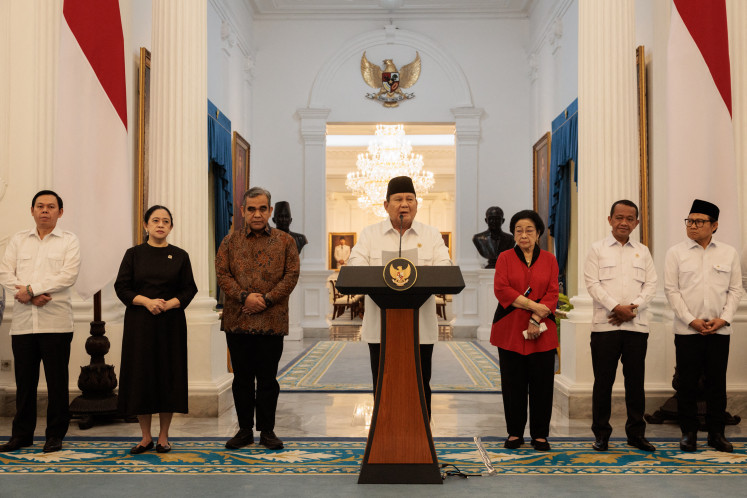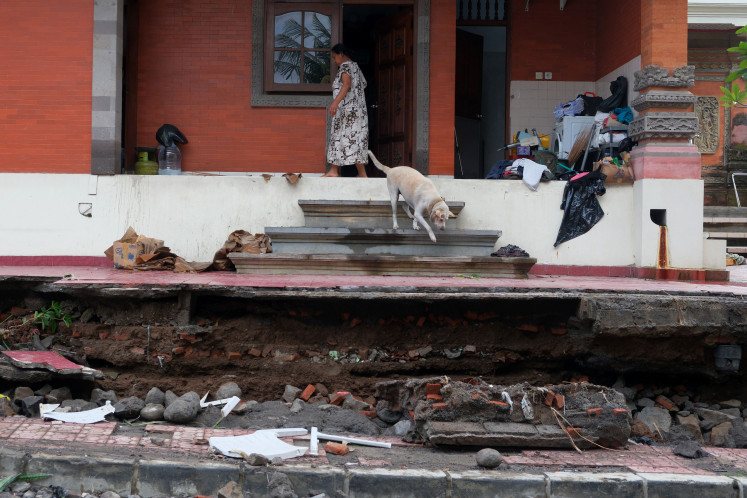Popular Reads
Top Results
Can't find what you're looking for?
View all search resultsPopular Reads
Top Results
Can't find what you're looking for?
View all search resultsStunting and child marriage
Outside cities like Jakarta, child marriage is still a common practice.
Change text size
Gift Premium Articles
to Anyone
N
etizens were shocked last April by news of teenagers in Bantaeng, South Sulawesi, who said they wished to wed. Their parents allowed the bride, 14-year-old Fitrah, and the groom, Syamsuddin, 16, to rush the wedding with the blessing of the local religious affairs office, citing it was the best measure to prevent premarital sex between the sweethearts.
Outside cities like Jakarta, child marriage is still a common practice. Some village communities prefer to marry their children at a young age, believing child marriage is a way out of poverty. Others believe child marriage is the most effective solution to minimize extramarital sex, which many consider sinful.
The Convention on the Rights of the Child, which Indonesia has ratified, defines a child as a human being aged below 18; thus, a marriage involving someone under 18 is internationally categorized as child marriage, although Indonesia’s marriage law permits girls even under 16 to wed with parental consent. According to Amnesty International, child marriage impacts 41,000 girls in lower-income countries every year. The 2015 National Social and Economic Survey (Susenas) also revealed that one out of five women aged 20 to 24 years old in Indonesia were married for the first time before they turned 18.
A study from Harvard Medical School on sub-Saharan Africa countries indicated intergenerational consequences for girls who get married and their development, including in health. In Indonesia, a comparison between provincial-level data on child marriage and stunting by Statistics Indonesia (BPS) in 2015 revealed that provinces with a high percentage of child marriages simultaneously recorded a high prevalence of stunting.
The report, which was based on the 2012 Susenas, revealed that West Sulawesi had the highest prevalence of child marriage at 37.3 percent, followed by Central Kalimantan at 36.7 percent and Central Sulawesi at 34.4 percent. This somewhat aligned with data that showed these provinces ranked among the top 10 provinces for stunting prevalence with 39.7 percent in West Sulawesi, 34.1 percent in Central Kalimantan and 32 percent in Central Sulawesi.
As for Central Kalimantan, the figures supported findings of a youth-led primary healthcare intervention program, Pencerah Nusantara (Light of the Archipelago), which found that the median age of pregnant mothers at the community health center (Puskesmas) of Tumbang Miri, Gunung Mas regency, was below 18 years old. Little have people realized that child marriage both induces lower economic income and a low education rate.
It also accounts for the alarming rate of stunting in Indonesia, where two out of five children under 5 experience impaired growth from poor nutrition, repeated infection and inadequate psychosocial stimulation, according to the World Health Organization (WHO).
Puskesmas Tumbang Miri detected that a significant 44 percent of children under 5 in Kahut municipality were stunted. Stunted children tend to experience greater difficulty in studying compared to those with sufficient nutritional intake. They are also likely to experience slow physical and mental development, reduced productive capacity and poor health, as well as have a higher risk of developing at an earlier stage non-communicable diseases, including cardiovascular diseases, diabetes and cancer during adulthood. If stunting continues, the World Bank estimated it could lead to a 2 to 3 percent loss of national gross domestic product.
Established to improve public nutrition, Pencerah Nusantara has been carrying out a longitudinal study in Gunung Mas regency for almost three years. It has thus far concluded that the prevention of stunting can be started by minimizing child marriage as it triggers teenage pregnancy, which increases the risk of maternal and infant death.
Together with Puskesmas Tumbang Miri as the local primary healthcare service, they initiated the Young Borneo program to boost the participation of young health volunteers, in instilling an understanding of reproductive health to their peers at schools.
In other areas with a relatively low amount of resources, local regulations better ensure the consistent implementation and monitoring of child marriage cases. This action mirrors what the mayor of Gunungkidul, Badingah, chose to do, as he prioritized children’s education over early marriage through a 2015 bylaw on child marriage.
This policy has been enforced in several villages, with Desa Mertelu having succeeded in suppressing child marriage. Five years since implementing the bylaw, Mertelu saw zero child marriage cases. This achievement is the real deal as Gunungkidul holds the highest child marriage rate in Yogyakarta province.
All relevant stakeholders, including religious leaders, village governments, educational institutions, NGOs and even local businesses, should work together in eliminating child marriage, which has contributed to high rates of stunting. There should be no more Fitriahs or Syamsuddins as children deserve a better quality of life through better education, healthcare access and working opportunities. Furthermore, we all have the responsibility of ensuring that stunting ends here and now. It can be started by eliminating child marriage.
***
Yeyen Yenuarizki is a communication for development specialist at the Center for Indonesia’s Strategic Development Initiatives (CISDI). Rizky Loviana Roza is a physician deployed in Gunung Mas regency, Central Kalimantan province, under the Pencerah Nusantara program. Pencerah Nusantara is a youth-led social movement that aims to improve primary healthcare services managed by CISDI.











